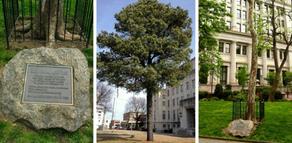
There could be 15 trees throughout the UK grown from seeds that were flown around the moon by NASA on the Apollo 14 mission, and scientists are trying to find them.
The Moon Trees, grown from orbiting seeds flown in 1971, could be anywhere in the UK, including in private gardens, according to the Royal Astronomical Society.
NASA astronaut Stuart Roosa took 500 seeds from Sycamore, Loblolly Pine and other varieties of trees with him as the Apollo 14 capsule orbited the moon.
Most were planted in the US, but it is thought about 15 came to the UK - and now the Royal Astronomical Society (RAS) and UK Space Agency are trying to find them.
The idea that 15 seeds came to the UK came from Gardener's Question Time presenter Christine Walkden, but so far no other evidence has been found.
The collection includes redwoods, Douglas firs, sycamores, sweetgums and loblolly pines, but about a third have died since being planted in the 1970s.
The mission was part of Apollo 14 and while astronauts Alan Shepard and Edgar Mitchell walked on the moon, Stuart Roosa orbited above in the command module with the seeds that sat his personal kit.
The seeds were sent to space in a bid to investigate whether and to what extent migrogravity affects plants, an experiment regularly repeated since 1971.
The space seeds were placed in Rossa's kit, but the canister burst open during the decontamination procedure after the crew returned to earth, leaving many unusable for the experiment.
'The resulting seedlings were planted throughout the United States (often as part of the nation's bicentennial in 1976) and the world. They stand as a tribute to astronaut Roosa and the Apollo program,' NASA shared in a statement.
NASA put the seeds in the care of the US Forest Service, which watched over them until they sprouted – but some were not planted until years after the mission.
In 2015 nearly four and a half pounds of rocket seeds spent six months on the International Space Station orbiting the Earth with British ESA astronaut Tim Peake.
When the seeds returned to Earth in 2016, children from schools and groups across the UK took part in an experiment to see if the radiation in space, which is up to 100 times more powerful than on Earth, would affect the seeds' germination.
The results showed that, while the rocket seeds grew more slowly and were more sensitive to ageing, they were still viable.
The UK is home to seven apple trees that also went on a mission of a lifetime when they travelled to the ISS with Peake, according to the RAS.
The UK Space Agency, which is supporting the hunt for the Moon Trees, cultivated the Apple Tree seeds from the very tree which inspired Newton to discover gravity.
There are currently over 60 Moon Trees known to be alive on Earth, grown from the seeds of the 1971 Apollo mission, the majority of which are in the US.
Other confirmed locations of the Moon Trees are in Brazil, Italy and Switzerland.
US locations include universities, schools, botanical gardens, state parks, court houses, space centres, and one at the White House - a Loblolly Pine planted in January 1977, six years after the seeds returned to Earth.
Source Daily Mail































